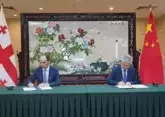The economic potential of the South Caucasus, as acknowledged by most international experts, is high, but far from being fully realized. In the past 10 years, the implementation of many profitable projects capable of improving the region's economy has proved impossible due to the disintegration of the South Caucasus.
Whereby, transport projects, realized by some regional states, brought them an obvious benefit. Due to its raw materials and transit opportunities, Azerbaijan is considered the economic center of the South Caucasus. Turkey has played a certain role in the development of its oil and gas sector. Launched in 2006, the Baku-Tbilisi-Ceyhan oil pipeline predetermined the mutually beneficial Baku-Ankara cooperation, allowing Azerbaijan to enter the European commodity market. Today, Azerbaijan and Turkey are successfully implementing the Trans-Anatolian Natural Gas Pipeline Project (TANAP), whose potential will be enhanced after the Trans-Caspian gas pipeline is commissioned. The current capacity of the TANAP gas pipeline is 16 billion bcm of gas per year, and can be increased to 60 billion.
The transit potential of the South Caucasus is realised in pipeline projects related to the oil and gas transportation from the Caspian deposits to Europe. At the same time, it is difficult to estimate the current volume of transit traffic through the countries of the region transversally (from east to west and from west to east). They could increase with the participation of Iran, but Tehran’s anti-American policy and subsequent sanctions pressure on Tehran makes the South Caucasus’s cooperation with Iran undesirable in the eyes of the West. (However, Armenia stands apart here, since the issue of bilateral economic contacts is of utmost importance for Yerevan).
Nevertheless, projects with the participation of Tehran exist, these include the International North–South Transport Corridor, which is to link the Baltic States with India through Iran. The corridor provides several cargo transportation routes. The Qazvin-Rasht-Astara railway route, being currently under construction, will be used for transit on the territory of Iran, the opening of which is scheduled for 2019. The project implementation will allow Russia, Azerbaijan and Iran to tap the full potential of the route with the subsequent entry into the Asian market.

The Nakhchivan Railway, one of the branches of which passed through the Julfa railway station on the territory of Azerbaijan Nakhchivan, was inherited by the region from the Soviet Union. In Soviet times, Iran's freight turnover with the USSR, Eastern Europe and Scandinavia passed through Julfa, which was one of the most important trade hubs.
Azerbaijan's connection with Turkey was previously possible through the territory of Armenia in the direction from Gyumri to Kars (the road is not used now, since Turkey closed its border with Armenia in 1993 and Nakhchivan is in blockade). The introduction of the Baku-Tbilisi-Kars railway line in last October made it possible to overcome the relative isolation. However, it did not solve the problem of a shortage of land cross-border routes between Turkey and Russia, which limits the possibilities of investing in the region. In the future, the connection of the North-South and Baku-Tbilisi-Kars routes on the territory of Azerbaijan will allow attracting carriers of cargo between Turkey and Russia to the new route. Thus, four countries will receive a railway route connecting them.
Georgia also has the opportunity to diversify its economic potential by participating in international projects. Over the past 15 years, the republic practically hasn't missed a single opportunity. Due to its close cooperation with Azerbaijan, Georgia has become a major transit country for energy resources, ensuring its energy security. Tbilisi welcomes any opportunity to promote the development of transport links between Turkey and Azerbaijan. Georgia does not play a strategic role as a supplier of raw materials or a consumer goods market, but remains a bridge for trade and communications between the South Caucasus, Central Asia and Europe. For this reason, Georgia's current status as a transit country suits both the EU, Turkey and Iran.
Meanwhile, Armenia is bypassed by all large-scale economic projects in the South Caucasus. Armenian economy's success is largely determined by its close integration into those projects led by Russia. Therefore, Armenia's main economic achievement over the past decades has been its accession to the EEU. The problem of Armenia's transport isolation seems to be unsolvable without the construction of a railway linking it with Iran, as well as the settlement of the Karabakh conflict.
The routes connecting Nakhchivan with Turkey and Iran are not transit and serve only local cargo flows, since Nakhchivan's borders with Armenia are closed. Armenia's closed borders with Azerbaijan and Turkey, the lack of cheap transport links with Russia and other countries of the EEU, as well as with the European Union, hinder the country's economic growth.
The future of the South Caucasus depends primarily on whether the regional states will be able to resolve existing conflicts, which increase the cost of freight traffic and prevent opening of the borders. Resolving the crises will ensure the demilitarization of the region and a marked reduction in the republic’s military budgets, which in the future will enable the countries of the region to develop joint high technology industries.










